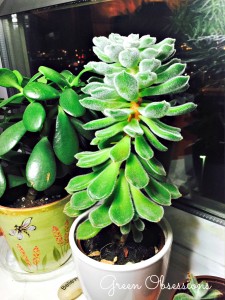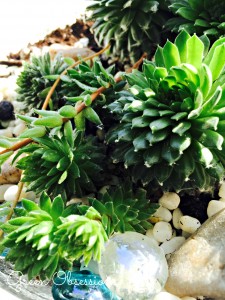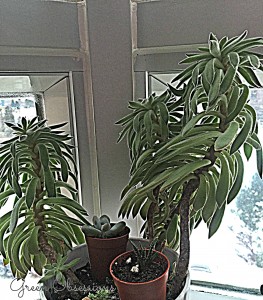
If you have read my very first posts then you know, my apartment faces north. It has a beautiful view of the Ottawa river, but not enough sun in winter. As a newbie plant enthusiast, I was too excited about adding plants to my home and did not consider factors such as the light requirements for the plants. I fell in love with succulents very early on in my green obsession and I wanted them all. I purchased a few succulents, creating beautiful arrangements that showed off my gardening prowess. With time however, I noticed the plants looked different. For example, the Sedum pictured above angled its stem towards the window in the winter. The leaves also looked exceptionally fanned out and elongated. That is when I realised it needed more sun than I could provide and sent it over to my sister-in-law’s house to overwinter there. Oh by the way, I still have not been able to identify this Sedum yet so if you have any idea please leave a comment below. It seems to be a cross of Sedum morganianum (donkey’s tail) and some other succulent. Their stems are thicker, not easily bendable and have bigger and longer leaves than donkey’s tail. I purchased three of them when they were about 2 cm high, thinking they would stay that small. To my surprise they started growing tall and out of the pot in no time. They are also easy to propagate just like donkey’s tail.
 |
Another distorted succulent I have is this Echeveria ‘Wooly Rose’ . I looks very elongated, atypical of this succulent. You may not have seen one like this before. I thought it was the normal growth pattern of this succulent but I found out later they rather grow short and compact. Look how long and spindly it is with large leaf spacings. This is because it is reaching for the sun that is non-existent in my home for all of winter. I was pleased though when it set out 3 pups and bloomed this past summer. You can see a little new plant growing at the bottom. To me, this means it is thriving and not a total lost cause. This is one tough plant and seems determined to grow and stay alive despite its conditions. It tends to lean towards the window and so I rotate it every few days to keep it from leaning one side. I have had to change the pot its in since writing this post as it was too top-heavy for the pot to support it. I haven’t decided whether i should behead it in spring and start over or leave it as is. Any suggestions? All in all, it is still a very beautiful plant and I just love the fuzzy hairy leaves. |
 |
The leaves of this Sempervivum arachnoideum aka cobweb houseleek also look elongated. It is very subtle but if you are familiar with this Sempervivum you will notice this. They also lost their ‘cobwebs’ which I presume is also due to the lack of bright light. I am unable to find information to confirm if this is the case. Once I noticed the loss of hairs and stretched out appearance, I took them too to my sister-in-law’s (a thousand thanks for putting up with more plants than you bargained for) who has windows facing south. Since then the cobwebs on the offsets you see in the picture have returned. I am not sure if that on the mature ones will return. They look much better now in their new home facing south. I plan to return them back to my home in the summer when I can enjoy them once again. Sort of a shared custody situation going on where I get them 4 months in a year :). |
 |
Etiolation is the term used to describe the process that occurs in plants growing in partial or complete absence of light. Etiolated plants have long, weak stems with smaller and sparser leaves (more space in between leaves). This process however increases the likelihood that plants will get access to some sun light. I imagine this works well for a plant in shade that needs more light in the wild. It is able to stretch out just to get enough light. For house plants, this process leaves you with an ‘interesting’ looking plant and those not familiar with the plant will be none the wiser.Look at this Echeveria runyonii ‘Topsy turvy’. It appears deformed and top-heavy. Silly me, I thought this is how they grow. Looking at pictures on line made me think otherwise. It has lots of pups though on the stem which will make me new beautiful plants. I plan to ‘chop the head’ off the main plant and re-pot it in the summer. I may leave the pups on the main stem to see what happens or take the whole stem out altogether if the pups are big enough to be on their own. |
 |
I have not quite figured out if the growth on the Echeverias pictured to the left is also due to etiolation as I have seen varying pictures of it on-line. I think they might be Echeveria set-oliver but not so sure. The stems look very spindly and the leaves are elongated as well. One of them has leaves that look like they are blowing in the wind. Any information about the normal growth of this succulent is welcome in the comments section.Despite not having bright sunlight about half the year, I still love succulents. My low light environment has taught me a few things about succulents which I will continue to share with you. Later, I will write a post about what succulents I have found to grow well in low light with minimal to no etiolation, so check back soon. |
If you have etiolated plants, I would love to see them. Please upload your pictures in the comment section below. What have you noticed about their growth? Did you leave them alone or started over from stem cuttings?
![]()
Share the Plant love:
Related
Barbara
Hi, I’m Barbara and I’m a little obsessed with house plants. I share my house plant adventures in the hopes of inspiring you to continue to enjoy the greens in your home. And if you have no plants (yet!) I hope this blog inspires you to add some green to your home. So go on! Try it! I think you might quite like it. And who knows? You may end up being … obsessed too.

Green Obsessions » Blog Archive » The Big Chop & Spring Blooms
[…] have a hideous succulent we would rather hide from prying eyes. Its form so grotesque (due to etiolation) that we may hide it when showing others our plant collections, in fear that they will see that we […]
25 . May . 2015